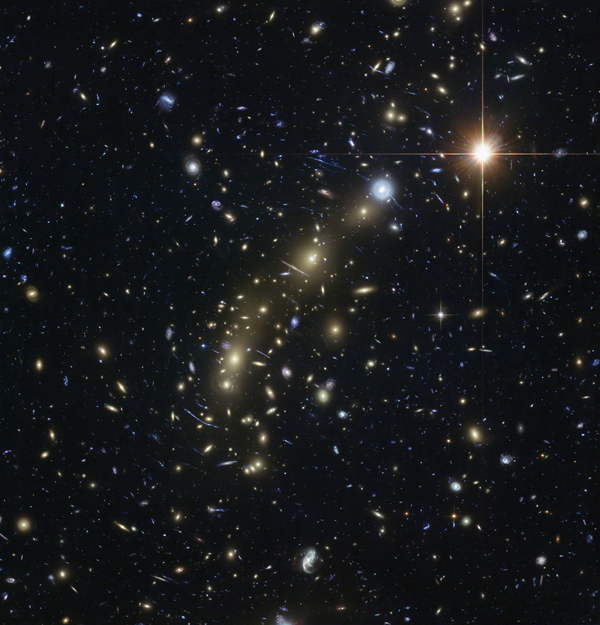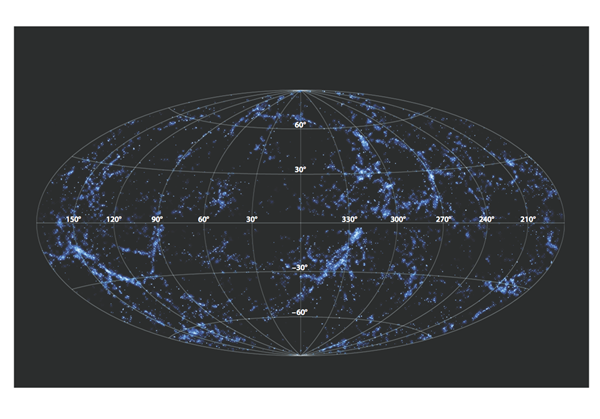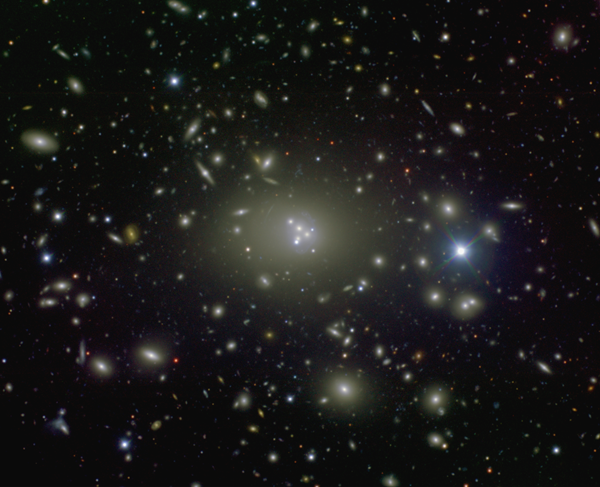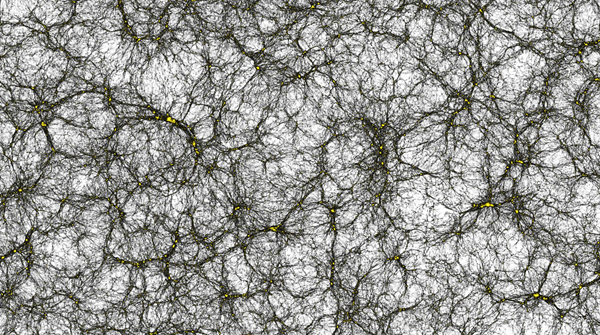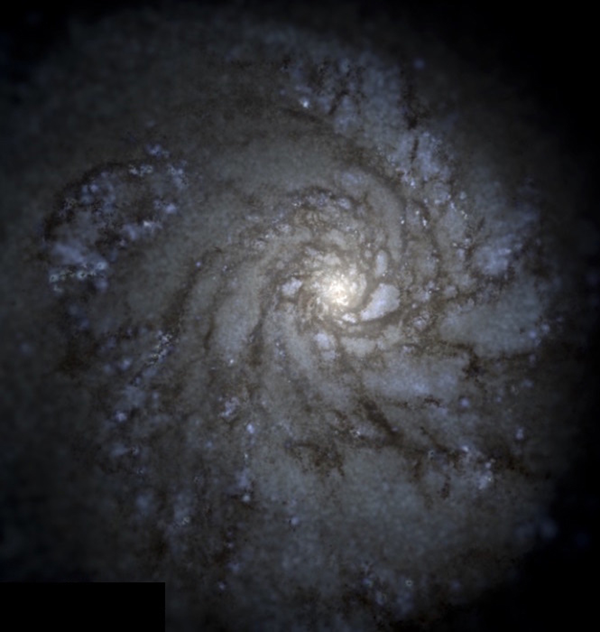One of the most striking features of the distribution of matter in the universe is its filamentary appearance, with long, luminous strands of galaxies woven together into a vast cosmic web.
Nowhere is this more evident than the Perseus-Pisces Supercluster. This colossal chain of galaxies snakes across more than 50° of the northern sky, fed by a network of smaller filaments that resemble tributaries flowing into a river. Embedded within these filaments are densely populated groups and clusters of galaxies. Between them lie immense voids.
Our own Milky Way Galaxy resides in the outskirts of a similar structure known as the Laniakea Supercluster. (Laniakea means “immeasurable heaven” in Hawaiian.) Home to an estimated 100,000 galaxies, it’s a tangled knot of filaments stretching half a billion light-years from end to end. University of Hawaii astronomer Brent Tully, whose team discovered Laniakea in 2014, likened it to “finding out for the first time that your hometown is actually part of a much larger country that borders other nations.”
Everywhere we look, galaxies trace out the paths of these filaments. But it turns out galaxies don’t just illuminate the cosmic web — they’re also shaped by it.
When the stars align
In 1874, less than a decade after the Civil War ended and long before anybody knew for certain what galaxies were, astronomer Cleveland Abbe wondered how “nebulae,” as galaxies were known in those days, are oriented in space.
To answer this question, Abbe chose 59 of the most extended nebulae in Sir John Herschel’s famous Catalogue of Nebulae and Clusters of Stars and measured their direction of elongation. His surprising conclusion was that the nebulae appeared to favor certain orientations with respect to the Milky Way. But his study drew little attention and was soon forgotten; Abbe moved on to a more successful career in meteorology.
Forty years later, American astronomer Edward Fath revisited Abbe’s question. After measuring the orientations of hundreds of galaxies on photographic plates taken at Mount Wilson Observatory, he reported in 1914 that they “appear to be oriented at random.”
Decades of lively debate followed. English amateur astronomer Francis Brown spent more than 30 years investigating galaxy alignments in his spare time. In a series of papers published between 1938 and 1968, he presented evidence that galaxy orientations in certain regions of the sky were far from random. But many astronomers remained skeptical, suggesting that the results might be a consequence of measurement errors, selection effects, or even psychological biases.
Why are galaxies elongated?
Most galaxies are elongated in shape; round ones are rare. But why?
A galaxy’s image is a snapshot of its stars’ motions, a moment frozen in time. Spiral galaxies like the Milky Way owe their flattened shapes to rotation. Just as a ball of pizza dough flattens when spun, a spiral galaxy’s stars spread into a thin disk as it rotates. Traveling at half a million miles per hour, our Sun has made nearly two dozen trips around the Milky Way since its birth.
Elliptical galaxies, on the other hand, have little or no rotation. Their stars swarm around the galaxy’s center like bees around a hive, each following its own seemingly random path. However, these orbits are often elongated in one direction more than others, stretching the galaxy into a shape resembling a luminescent football. — M.W.
Then in 1968, Gummuluru Sastry of Wesleyan University showed beyond any doubt that the orientations of some galaxies are clearly not haphazard. Sastry discovered that giant elliptical galaxies that populate the centers of clusters — the biggest and brightest galaxies in the universe — have a remarkable tendency to be elongated in the same direction as their host cluster. For example, if a cluster is elongated north-south, then more often than not, its brightest member galaxy is, too. If galaxies were human, psychologists would call this a textbook example of mirroring behavior.
Although Sastry’s conclusion was based on only five galaxies, other astronomers have subsequently confirmed his results with much larger samples. Recent studies with the Hubble Space Telescope — whose sharp vision allows us to see the remote past by looking far into space — reveal that these alignments even existed billions of years ago.
And there’s more.
In 1981, Bruno Binggeli of the University of Basel in Switzerland showed that clusters of galaxies aren’t oriented at random, either. Instead, they exhibit a remarkable tendency to “point” toward neighboring clusters. Binggeli’s discovery was anticipated a few years earlier by Estonian astronomers Jaan Einasto, Mihkel Jõeveer, and Enn Saar.
They noticed that clusters in the Perseus-Pisces Supercluster are elongated in the same direction as the filament that bridges them, leading them to suggest in a 1980 paper published in Monthly Notices of the Royal Astronomical Society that “the orientation of clusters in superclusters is a conspicuous morphological property of superclusters.”
The alignment of galaxies and clusters over tens or hundreds of millions of light-years means the innermost regions of some galaxies are aligned with their surroundings on scales larger than 1,000 times the size of a single galaxy itself. It suggests that the birth and evolution of these objects have been strongly influenced by the cosmic web. But how?
Smearing cosmic shear
One astronomer’s signal is sometimes another’s noise.
Charles Messier compiled his famous list of deep-sky objects to spare fellow comet hunters from wasting time on them. Edmund Weiss, a 19th-century Austrian astronomer, called asteroids the “vermin of the sky” because their trails on long-exposure photographs were considered blemishes. And galaxy alignments turn out to be a nuisance for some astronomers, too.
Gravitational lensing, the deflection of light rays by gravity, has become a powerful tool for cosmology. As light from faraway galaxies journeys through space, the gravitational pull of matter — both visible and invisible — alters its path. This causes galaxies near each other in the sky to appear slightly elongated and aligned. Astronomers call these distortions cosmic shear.
Although it’s a minuscule effect, by carefully measuring the shapes and orientations of large numbers of galaxies, astronomers can infer the amount and distribution of dark matter, the mysterious stuff that makes up much of the universe.
But a crucial assumption in cosmic shear studies is that galaxy orientations are inherently random, so that any apparent alignments are the result of gravitational lensing. Physical alignments, such as those seen in giant elliptical galaxies, masquerade as cosmic shear and complicate analysis.
So, while intrinsic alignments provide important clues about how environment shapes galaxies, they’re a nuisance for scientists whose goal is mapping the dark matter content of the universe. — M.W.
Going with the flow
Galaxies, like people, are products of their environment. Elliptical galaxies, for example, usually huddle together in groups and clusters, while spiral galaxies prefer more elbowroom.
Environment clearly plays a role in galaxy orientations, too. There are two leading theories for how this happens. One suggests that galaxies are born aligned with their surroundings, while the other assumes that alignment is something they acquire later.
Galaxies might gain their orientation in several ways. Big galaxies grow by cannibalizing smaller ones, a process astronomers euphemistically call merging. But mergers aren’t haphazard. Computer simulations show that they occur most frequently along well-defined directions as gravity shepherds material along filaments. This imprints a built-in memory of their environment on these cannibals, one that reflects the surrounding cosmic web. In a sense, giant galaxies are like spiders waiting for prey, only it is smaller galaxies rather than bugs that they devour, and the web they sit in is elongated rather than circular.
Alternatively, given enough time, gravity’s relentless tug will slowly reorient galaxies until they align with their surroundings. Theoretical calculations and computer simulations suggest this should occur on timescales shorter than the age of the universe, which means that even if a galaxy was initially misaligned with its surroundings, it should have fallen into line by today.
As is often the case in science, it’s possible, even likely, that there’s more than one explanation for galaxy alignments, with mergers along filaments and twisting due to gravitational effects both contributing to the end result.
Simulating the universe
In 1941, five years before digital computers were invented, Erik Holmberg of Lund Observatory in Sweden performed the first simulation of colliding galaxies. What he lacked in computational power he made up for with ingenuity.
Because an object’s gravitational pull and apparent brightness both vary inversely with the square of distance, Holmberg realized he could use light as a proxy for gravity. Representing two galaxies with 37 lightbulbs each, he measured the brightness at different locations to determine the strength and direction of the gravitational force and adjusted their motions accordingly. Although crude, Holmberg’s analog computation provided insights into the frequency of galaxy mergers and suggested that close encounters could generate spiral arms.
Astronomers quickly embraced digital computers as a tool to simulate events and timescales beyond anything accessible to mere mortals. In the 1970s, brothers Alar and Jüri Toomre pioneered numerical simulations of galaxy mergers by representing each galaxy as a swarm of interacting particles whose trajectories were calculated by the computer. Although the available computing power at the time limited the number of particles that could be followed, these simulations revealed that galaxy mergers are common, and that mergers of spiral galaxies can produce things that look like elliptical galaxies.
As computational power grew, so did astronomers’ ambition. Today, thanks to state-of-the-art computers, it’s possible to simulate the evolution of enormous volumes of space in unprecedented detail using trillions of particles to represent both luminous and dark matter. Beginning from some assumed set of initial conditions, astronomers can run the simulation forward in time to see what the predicted distribution and properties of galaxies would be today and then compare the results with observations. Such simulations have become an invaluable tool for understanding how the universe reached its present state. — M.W.
Is there more to cosmic congruence?
“Things are the way they are because they were the way they were,” maverick astronomer Fred Hoyle once quipped.
Beginning with the thinnest of strands — tiny irregularities in the primordial distribution of matter — gravity has slowly woven a cosmic web of sublime beauty and complexity. It’s astonishing to think that the filamentary distribution of matter on large scales is not only traced by galaxies and clusters, but also reflected in their orientations.
There’s tantalizing evidence that alignments might even extend to other scales. In 2014, a team led by Damien Hutsemékers from the University of Liège in Belgium reported that the spin axes of some quasars are parallel to each other over distances of billions of light-years, and that they share the same orientation as the surrounding filamentary structure.
If confirmed, this would suggest that the cosmic web has even influenced the supermassive black holes powering quasars, further evidence of a truly remarkable coherence of structures in the universe.
Michael West is deputy director for science at Lowell Observatory in Flagstaff, Arizona. His most recent book is A Sky Wonderful With Stars: 50 Years of Modern Astronomy on Maunakea.

